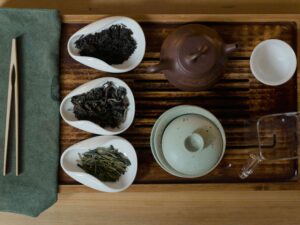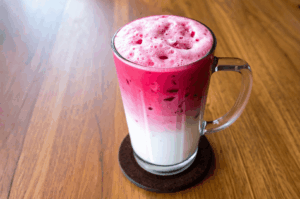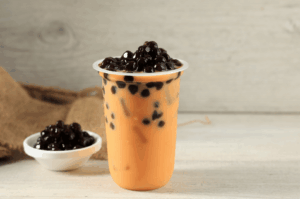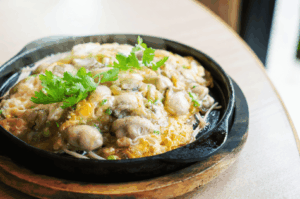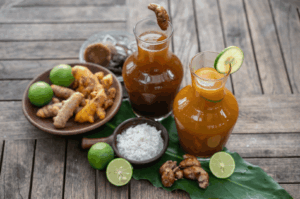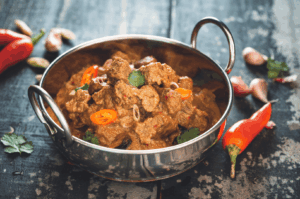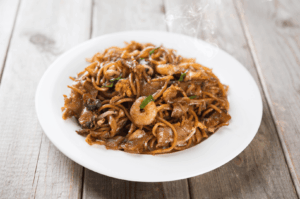
The air in Penang is thick with anticipation, carrying the sounds and smells of Malaysian street food being crafted with expert care. Your attention is captured by one of the many street vendors, a master standing before a seasoned wok glowing over an intense fire. The rhythmic clanging of metal on metal is the soundtrack to a mesmerising performance. A mixture of flat rice noodles, cooked shrimp, and bean sprouts is tossed into the air, briefly vanishing into a cloud of fragrant, smoky steam. This is the captivating theatre of the street stalls, and the star of this culinary show is Penang Char Kway Teow.
This isn't just a simple dish of noodles. It’s a plate loaded with history, an iconic dish that represents the soul of local food. Join us on this exploration as we uncover the secrets behind this famous stir fried meal and discover what makes the Penang version a global benchmark for flavour.
From Humble Meal to National Icon

Char Kway Teow, which is literally translated from the Hokkien dialect as "stir-fried rice cake strips," began its life as a hearty, calorie-rich meal. Its roots lie with the Teochew immigrants who settled across Southeast Asia. Initially, it was the go-to food for labourers and fishermen who needed an affordable, filling, and energy-dense dish to get through a gruelling day's work. The high-fat content, traditionally from pork lard, provided essential energy, while the noodles and other simple additions offered substance.
Over many years, this humble dish transformed from a purely functional meal into a culinary masterpiece. It became a fixture in the lively ecosystem of Malaysian coffee shops and bustling food courts. Today, it stands as a proud symbol of Malaysia's multicultural food scene, cherished by locals and eagerly sought by travellers on a quest for authentic taste experiences. No culinary tour of Penang is complete without it.
The Anatomy of an Authentic Plate
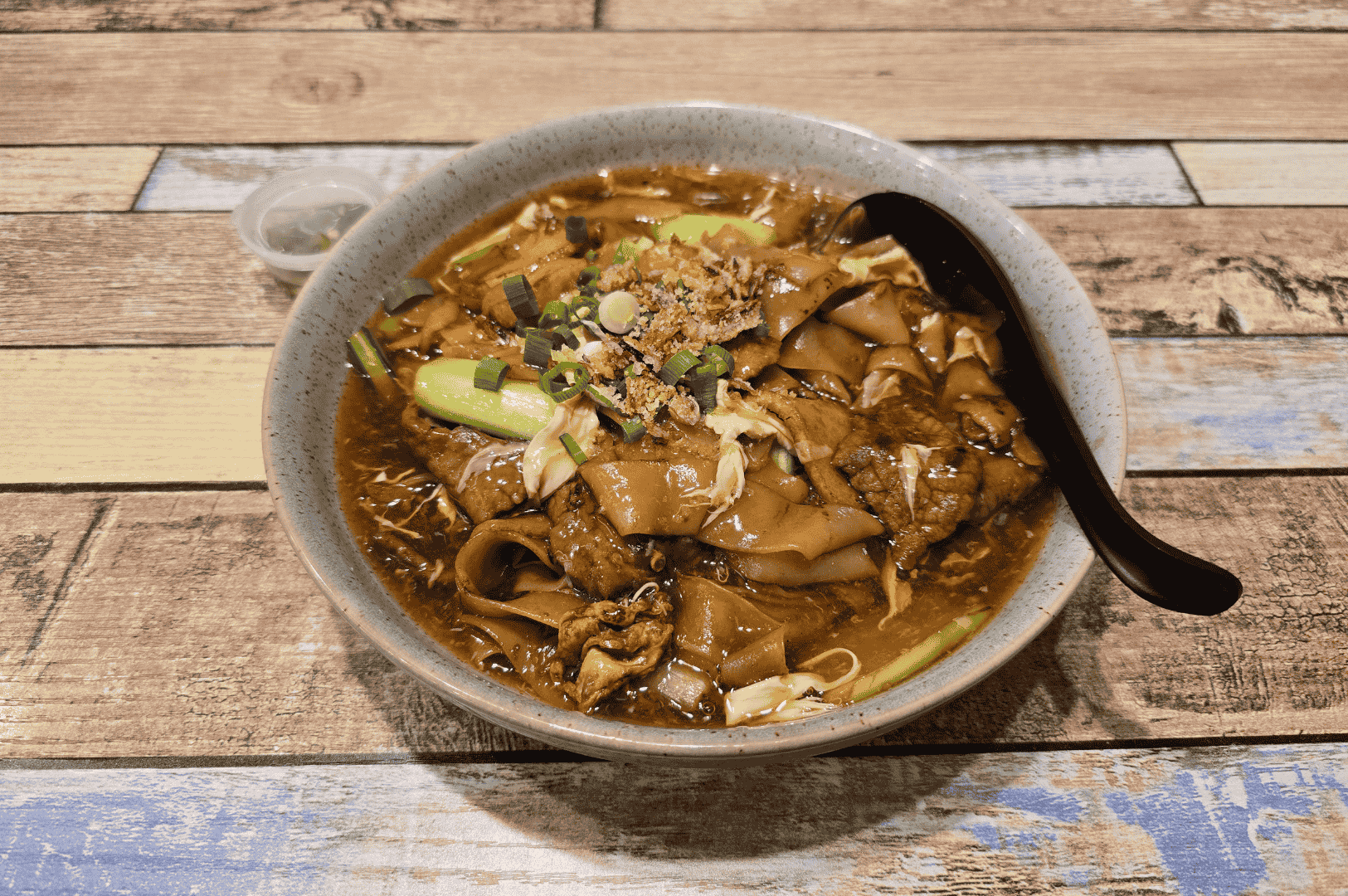
What elevates a basic stir fry to legendary status? The magic of a good Char Kway Teow is in the flawless harmony of its core components. Every single ingredient is selected for a specific texture and flavour, and the quality of each is essential for an authentic experience.
The Core Ingredients
- Rice Noodles: The heart of the dish is the kway teow, which are soft, slightly chewy flat rice noodles perfect for soaking up the savoury sauce. Sometimes, vendors use dried flat rice noodles which are prepared in boiling water before cooking. Often, these are mixed with a portion of yellow egg noodles to create a more complex texture.
- Shrimp: Fresh, juicy cooked shrimp are a cornerstone. They must be plump and sweet, adding a touch of seafood luxury. In Penang, the shrimp are often impressively large.
- Blood Cockles (See Hum): This is a defining, if sometimes polarising, ingredient. Lightly blanched, these small clams add a briny, metallic burst of flavour that many connoisseurs consider non-negotiable. You can, of course, request your plate without them.
- Chinese Sausage (Lap Cheong): These sweet, cured pork sausages are thinly sliced. As they cook, they release their fat and distinct sweetness into the dish, creating a beautiful balance with the savoury elements.
- Bean Sprouts (Taugeh): Added near the end of the cooking, they provide a vital element of freshness and a satisfying crunch that cuts through the richness of the meat and sauce.
- Chinese Chives (Ku Chai): Also known as garlic chives, these are chopped into sections and add a mild, onion-like freshness and a pop of vibrant green.
- Egg: Duck eggs are traditionally favoured in Penang for their richer yolk and creamier texture, which luxuriously coats the noodles. Chicken eggs are also commonly used.
- Pork Lard & Crispy Lardons: This is the secret weapon for many old-school vendors. Rendered pork fat is the traditional cooking oil, imparting an unparalleled flavour and aroma. The crispy fried cubes of lard are a decadent garnish.
- The Sauce: The exact recipe for the sauce is a closely guarded secret for many, but it's typically a sophisticated blend. It often includes dark soy sauce for colour and sweetness, light soy sauce for saltiness, and a chili sauce or chili paste like chili boh for a spicy kick. Some modern variations might even include a touch of oyster sauce for added umami.
The Soul of the Wok: Chasing "Wok Hei"
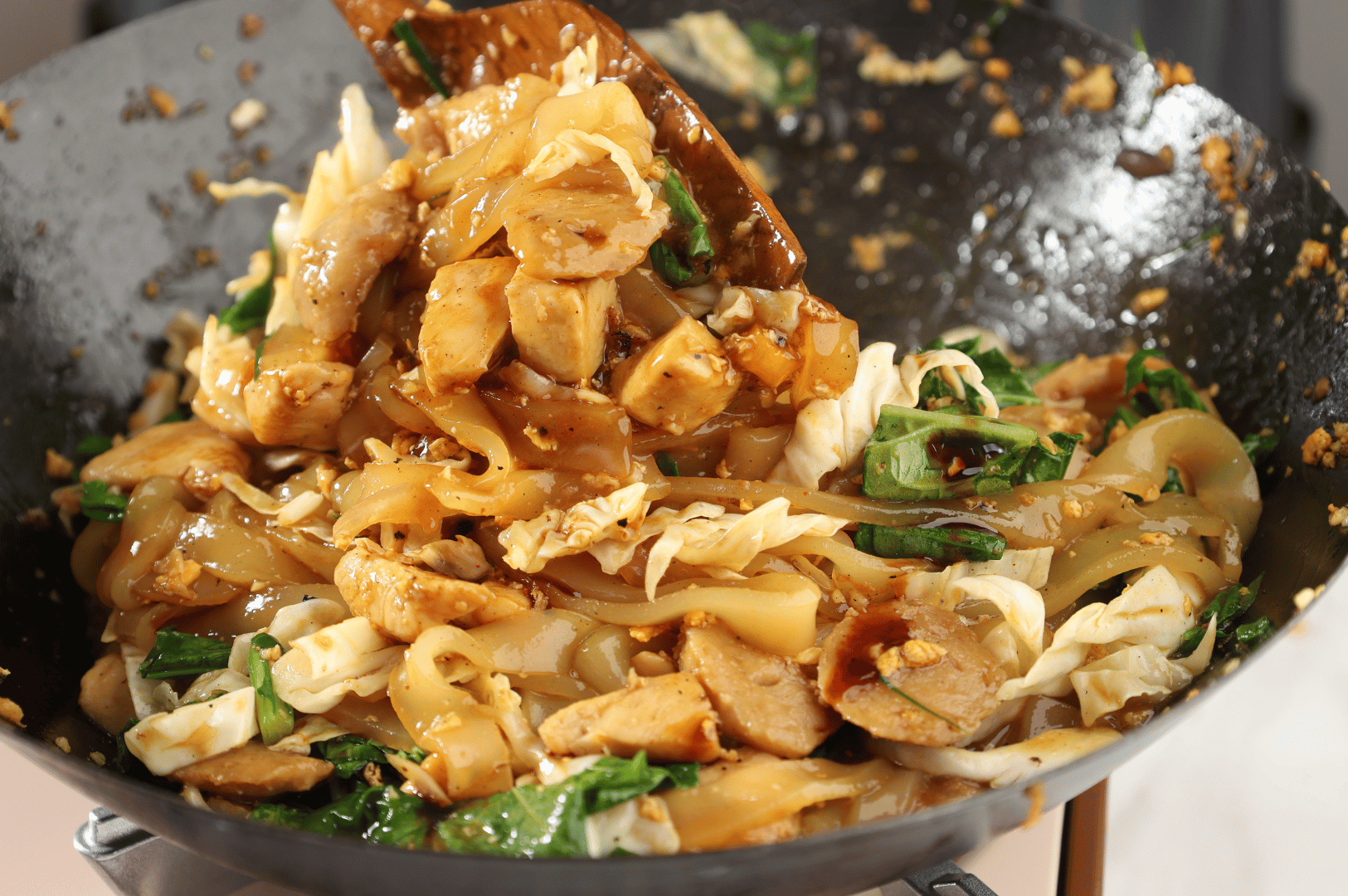
You could gather the world's finest ingredients, but without the right technique, you cannot create a genuine Char Kway Teow. The key to its signature smoky flavour is a concept known as wok hei.
Wok hei translates to "breath of the wok." It is that elusive, smoky, and slightly charred flavour that can only be achieved when cooking at an extremely high heat in a good wok. A well-seasoned wok is crucial. The intense heat, often from a roaring charcoal fire, causes the sauce to caramelise instantly upon hitting the hot metal. The food is tossed relentlessly, allowing it to connect with the searing surface without burning. This process imparts a distinct aroma that simply cannot be replicated on a standard kitchen stove. The noodles should be allowed to cook undisturbed for moments at a time to develop that char.
A master hawker orchestrates this with incredible speed. Garlic is flash-fried in cooking oil, followed by the noodles and Chinese sausage. The soy sauce blend is added, and the wok erupts in a cloud of aromatic steam. The shrimp, egg, and finally the bean sprouts and chives are tossed in, each at a precise moment to ensure it is perfectly cooked. The entire process takes just a few minutes, resulting in a dish that is smoky, savoury, sweet, and spicy all at once. The final plate is often served immediately, sometimes on a banana leaf for extra fragrance.
Penang Style vs. Other Variations
While you can find Char Kway teow across Malaysia and Singapore, the Penang version is widely seen as the gold standard. So, what sets it apart from the many variations?
- The Flavour Profile: Penang-style Char Kway Teow is predominantly savoury, with a pronounced seafood flavour, distinguishing it from sweeter, darker versions found elsewhere. It is a popular snack that balances its elements perfectly.
- The "Wetness": It tends to be slightly moister than other regional styles, with the sauce clinging to the noodles without making the dish soupy.
- Ingredient Focus: The use of large, fresh shrimp, blood cockles, and rich duck eggs are hallmarks of the Penang style. Other additions found in different regions, like fish cake, fish balls, or minced meat (like minced pork), are less common here. It is traditionally served without a side of cucumber slices.
- The Fire: Many legendary street stalls in Penang still insist on using charcoal fires, believing it is the only way to achieve true wok hei.
Where to Find Legendary Char Kway Teow
Your culinary journey in Penang should include a quest for the best plate. While "the best" is always a matter of personal taste, here are a few iconic street vendors that consistently deliver an unforgettable experience.
- Siam Road Char Koay Teow: Possibly the most famous of them all, this stall is known for its legendary queues. The elderly uncle helming the wok is a local celebrity, using a traditional charcoal fire to produce a plate that is intensely smoky and packed with juicy shrimp. The wait is long, but the reward is a truly authentic flavour.
- Ah Leng Char Koay Teow (Kafe Khoon Hiang): Ah Leng offers a "special" version that is a true indulgence, loaded with extra-large prawns or even mantis shrimp. It’s a pricier option, but the quality of the seafood is exceptional. It’s a firm favourite among those seeking a premium plate of this iconic dish.
- Lorong Selamat Char Koay Teow (Kafe Heng Huat): Known for its fiery "auntie" who wears goggles to protect her eyes from the oil, this stall serves a flavourful and slightly wetter version of the dish. The plates come piled with large chunks of fresh shrimp, making it a visually impressive meal.
- Tiger Char Koay Teow (Ping Hooi Coffee Shop): A classic spot for breakfast and lunch, this stall has been operating for decades. They use a gas-fired stove but still achieve a remarkable level of wok hei. Their version is consistently delicious and a great introduction for anyone new to the dish.
Beyond Char Kway Teow: A World of Malaysian Street Food

While Char Kway Teow might be king, Penang is a paradise of Malaysian street food. When you're not queuing for noodles, you can explore other local delights. Try Asam Laksa, a spicy and sour fish-based noodle soup with shredded mackerel, or Hokkien Mee, a rich prawn noodle soup. Don't miss out on Nasi Lemak, fragrant rice cooked in coconut milk and served with spicy sambal, or Roti Canai, a flaky flatbread perfect for dipping.
You can also find other noodle dishes like Mee Goreng (a different style of fried noodles) and delicacies from other cultures, such as Dim Sum in the morning or dishes from the stalls in Little India. For dessert, try shaved ice (ais kacang) topped with red beans, sweet corn, and green rice flour jelly, drizzled with palm sugar syrup and condensed milk.
An Essential Penang Experience
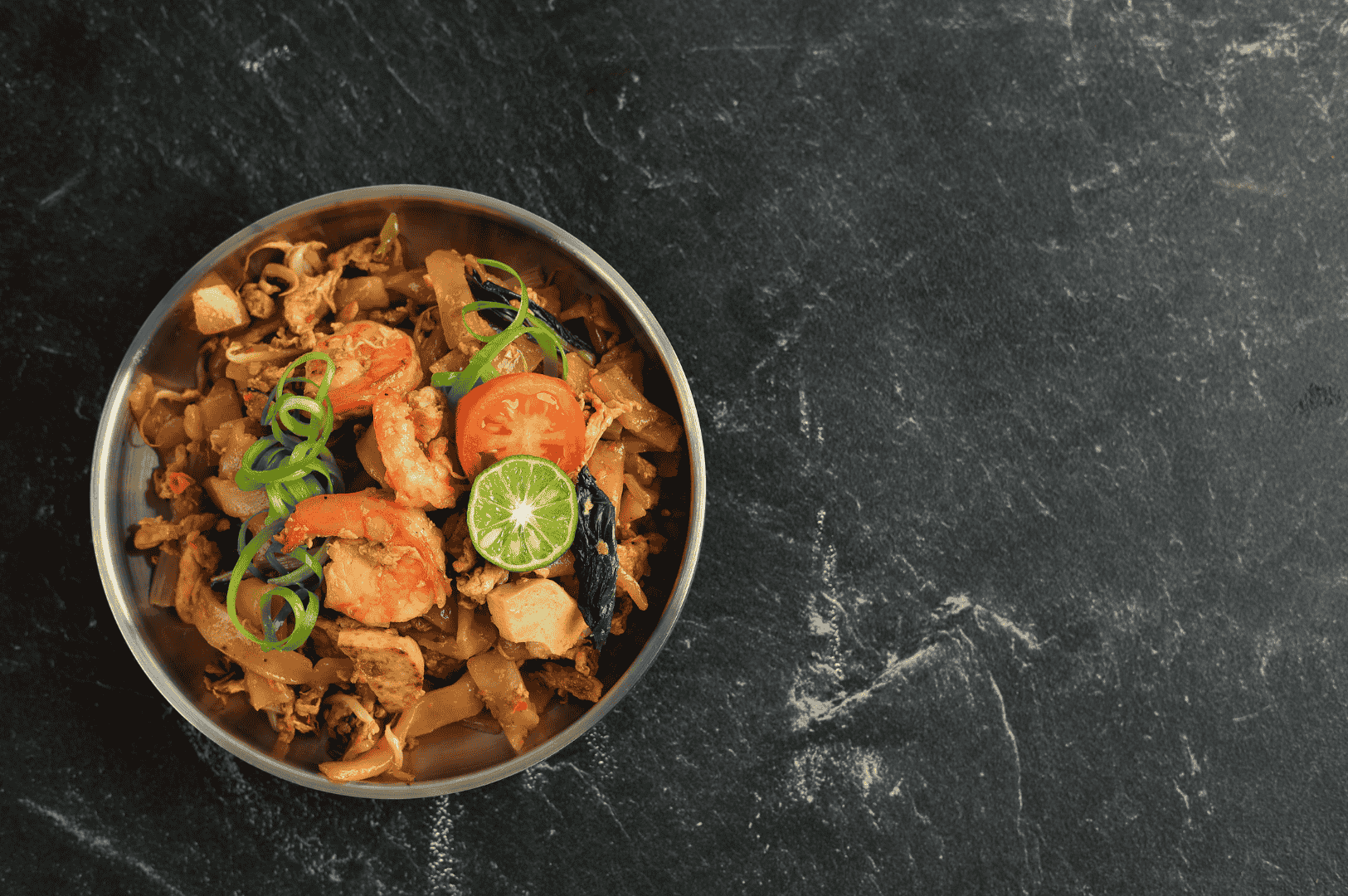
Char Kway Teow is more than just food; it's a celebration of flavours, a display of incredible skill, and a taste of Penang's soul. Watching the masters start cooking is a spectacle, and tasting the final product is a rite of passage for any visitor. The interplay of smoky noodles, sweet Chinese sausage, briny blood cockles, and fresh shrimp creates a complex symphony that lingers long after the final bite.
To visit Penang and not try a plate of authentic Char Kway Teow from a seasoned wok would be to miss out on one of Southeast Asia's greatest street food treasures. So, find a hawker stall, pull up a plastic stool, and prepare for a culinary journey you won't soon forget.
If you enjoy uncovering the traditions behind shared meals and ancient cooking methods, explore more about communal dining culture across Asia and the centuries-old dumpling techniques that continue to shape today’s kitchens.
The Art of Asian Tea Ceremony Traditions: Ancient Rituals and Cultural Values Across Asia
Dio Asahi | November 15, 2025
A cup of tea, in many parts of Asia, represents far more than a beverage-it is a conduit to ancestral tradition, intellectual pursuit, and the cultivation of mindfulness. Asian tea ceremony traditions turn the act of drinking tea into a sophisticated art form, layered with symbolism, philosophy, and socio-cultural values. Each gesture, from scooping powdered…
The Art of Slow-Cooked Curry Recipes: Time’s Magic in South Asian Cuisine
Eda Wong | November 13, 2025
Step into a South Asian kitchen, and the senses are instantly enveloped by the inviting aroma of food slowly simmering in a sturdy clay pot or heavy vessel. The allure is undeniable: in this space, slow-cooked curry recipes are a celebration of patient tradition, spices, and the richness of South Asian cuisine. Here, time and…
Bandung Drink Recipe: A Singaporean Rose Syrup Drink Tradition
Eat Drink Asia Team | November 11, 2025
Step into any night market or hawker centre in Singapore, and you’ll spot a vibrant, glowing glass filled with a cold, beautiful drink-Bandung. Known for its iconic blush-pink hue and refreshing taste, this rose syrup drink is an integral part of Singapore’s beverages scene and a cherished tradition in Southeast Asian gatherings. More than just…
The Ultimate Hainanese Chicken Rice Recipe: A Deep Dive
Eda Wong | November 8, 2025
To wander through Singapore’s bustling hawker centres on a humid evening is to experience a symphony of sights, sounds, and smells. Among the many other dishes sizzling away, one plate stands out for its elegant simplicity: Hainanese Chicken Rice. It arrives without fanfare-gleaming slices of poached chicken over fragrant rice, flanked by a trio of…
Bubble Tea Origins: How Taiwan Created a Global Beverage Phenomenon
Dio Asahi | November 6, 2025
From Taipei to New York, a single drink has captured the world’s taste buds: bubble tea. This beverage, known as pearl milk tea or boba tea, and also known as boba in many regions, is celebrated for its delightful combination of sweet, creamy tea and signature chewy tapioca pearls. What began as a novel creation…
A Food Lover’s Guide to the Taiwanese Oyster Omelet
Eat Drink Asia Team | November 4, 2025
As twilight descends upon Taipei City, a vibrant energy pulses through its streets. This is the hour of the night markets, bustling hubs of community, commerce, and some of the world’s most incredible street food. Amidst the steam from soup dumplings and the sizzle of Taiwanese fried chicken, one iconic dish reigns supreme: the Taiwanese…
Jamu: Indonesian Herbal Medicine for Modern Well-Being
Dio Asahi | November 1, 2025
Across the Indonesian archipelago, a vibrant tradition of herbal healing has flourished for centuries. This is jamu, a cornerstone of Indonesian cultural heritage and a sophisticated system of traditional herbal medicine. Far more than just a refreshing drink, jamu represents a philosophy of balance, a deep connection to nature, and a form of indigenous medicine…
Padang Beef Rendang: The Complex Process Behind Indonesia’s Most Famous Dish
Eda Wong | October 30, 2025
This post may contain affiliate links. For full transparency, this article may contain affiliate links. To call Padang beef rendang simply a dish is to miss the soul of Indonesian cuisine. This legendary slow-cooked dry curry, a centerpiece of both festive tables and humble meals, has earned its fame as one of the world’s most…
Teh Tarik Malaysia: The Art and Science Behind Iconic Pulled Tea
Eat Drink Asia Team | October 28, 2025
In Malaysia, ordering a cup of teh tarik is about so much more than just enjoying a hot drink. Teh tarik, literally translated as “pulled tea,” is Malaysia’s national beverage, famous for its sweet, creamy taste, frothy top, and the spectacular pulling technique seen in bustling mamak stalls and coffee shops across the country. A…
The Legendary Penang Char Kway Teow: A Culinary Journey
Dio Asahi | October 25, 2025
The air in Penang is thick with anticipation, carrying the sounds and smells of Malaysian street food being crafted with expert care. Your attention is captured by one of the many street vendors, a master standing before a seasoned wok glowing over an intense fire. The rhythmic clanging of metal on metal is the soundtrack…

